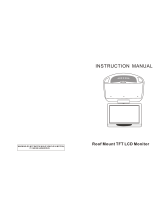
S A F E T Y I N S T R U C T I O N S
1. Read All Instructions. All safety and operating
instructions must be read before operating the
product.
2. Retain All Instructions. All safety and operating
instructions must be retained for future reference.
3. Heed All Warnings. All warnings on the product
and those listed in the operating instructions must
be adhered to.
4. Follow All Instructions. All operating and product
usage instructions must be followed.
5. Heat. This product must be situated away from any
heat sources such as radiators, heat registers, stoves,
or other products (including power amplifiers) that
produce heat.
6. Ventilation. Slots and openings in the product are
provided for ventilation. They ensure reliable
operations of the product, keeping it from
overheating. These openings must not be blocked
nor covered during operation. This product should
not be placed into a rack unless proper ventilation is
provided through following the manufacturer's
installation procedures.
7. Water and Moisture. Do not use this product near
water – for example; near a bath tub, wash bowl,
kitchen sink or laundry tub; in a wet basement; or
near a swimming pool or the like.
8. Attachments.
Do not use any attachments not
recommended by the product manufacturer as they
may cause hazards.
9. Power Sources. This product must be operated from
the type of power source indicated on the marking
label and in the installation instructions. If you are
not sure of the type of power supplied to your
facility, consult your local power company.
10. Grounding and Polarization. This product is equipped
with a polarized AC plug with
ground pin. Do not defeat the safety ground in any
manner.
11. Power Cord Protection. Power supply cords must be
routed so that they are not likely to be walked on
nor pinched by items placed upon or against them.
Pay particular attention to the cords at AC wall
plugs and convenience receptacles, and at the point
where the cord connects to the product.
12. Lightning. For added protection for this product
during a lightning storm, or when it is left
unattended and unused for long periods of time,
u
nplug it from the AC wall outlet. This will prevent
damage to the product due to lightning and power
supply surges.
13. Overloading.
Do not overload AC wall outlets,
extension cords, or integral convenience outlets as
this can result in a fire or electric shock hazard.
14. Object and Liquid Entry. Never push objects of any
kind into this product through openings as they may
touch dangerous voltage points or short out parts
that could result in a fire or electric shock. Never spill
liquid of any kind into the product.
15. Accessories. Do not place this product on an unstable
cart, stand, tripod, bracket, or table. The product
may fall, causing serious damage to a child or adult,
and serious damage to the product. Any mounting of
the product needs to follow manufacturer's
installation recommendations.
16. A Product and Cart Combination should be moved with
care. Quick stops, excessive force, and uneven
surfaces may cause the product and the cart
combination to overturn.
17. Servicing.
Refer all servicing of the product to
qualified service personnel.
18. Damage Requiring Service. Unplug this product from
the AC wall outlet and refer servicing to qualified
service personnel under the following conditions:
• When the AC plug is damaged.
• If liquid has been spilled or objects have fallen into
the equipment.
• If the product has been exposed to rain or moisture.
•
If the product does not operate normally (following
operating instructions).
• If the product has been dropped or damaged in any
way.
• When the product exhibits a distinct chang
performance. This indicates a need for service.
19. Replacement Parts.
When replacement parts are
required, be sure the service technician has used
replacement parts specified by the manufacturer or
that have the same characteristics as the original
parts. Unauthorized substitutions may result in fire,
electric shock, or other hazards.
20. Safety Check. Upon completion of any repairs to this
product, ask the service technician to perform safety
checks to determine that the product is in safe
operating condition.
21. Cleaning.
Do not use liquid cleaners or aerosol
cleaners. Use only a damp cloth for cleaning.



























